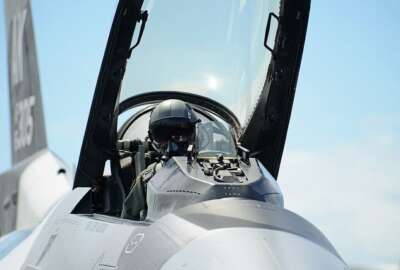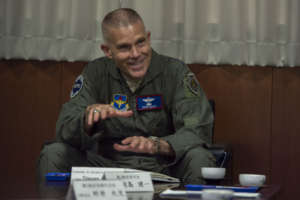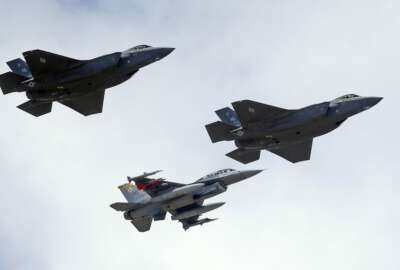
New Air Force pilot training strategies lean heavily on AI ‘coaches’
The commander of Air Education and Training Command wants to overhaul the service's process for training new pilots, and artificial intelligence will play a major...
Best listening experience is on Chrome, Firefox or Safari. Subscribe to Federal Drive’s daily audio interviews on Apple Podcasts or PodcastOne.
The Air Force’s top training official said his service is moving toward an entirely new “paradigm” for how it teaches new airmen to fly airplanes. It’s likely to involve at least as big a role for artificial intelligence as it does for human instructors.

The overall objective is to move away from an “industrial age” training model with pre-set timetables and instruction plans to one that adapts to each airman’s learning pace.
The assumption that the Air Force needs a new kind of training flows from the service’s belief that it also needs a new kind of pilot. That’s partly, though not entirely because of the impending introduction of the F-35 into the Air Force’s fighter jet inventory, and the fifth-generation plane’s advanced sensors.
“Ten years ago, a new pilot in a normal air superiority fighter or air-to-ground fighter really didn’t have to think like a mission commander. But in the F-35, because of its power to be able to see the photonics spectrum and the electromagnetic spectrum, every pilot coming in from day-one is acting like a mission commander,” Lt. Gen. Steven Kwast, the commander of Air Education and Training Command, told reporters Wednesday. “They need to be able to conduct the entire strategy for the campaign, because they will see things that others cannot see, and it’s a different way of thinking. Normally, we take years to grow somebody into that kind of cognitive complexity to be able to do multi-domain order of battle decision making strategies, but now we need that on day one. And the good news is young minds are capable of learning that pretty darn fast.”
AI coaches appear ‘highly effective’
AETC thinks artificial intelligence and augmented reality technologies are the key to accelerating that kind of training. Things are still in the early beta test stage, but the command hopes to have machine-assisted training methodologies ready to propose to the secretary of the Air Force by next year.
And Kwast said the early results are promising. Among other benefits, they appear to show that artificial intelligence “coaches” are highly effective at gathering data from the process of training any particular pilot, and then refocusing that process on exactly the areas in which the student needs the most help.
“For example, a pilot has to do a loop. The artificial intelligence is watching you do that loop, and as you pull back on the stick, it can tell what you’re doing and say, ‘Hey, you’re pulling back too much.’ It’s not only telling you what to do, it’s learning how you learn, and it’s giving you advice that’s helping you real-time,” he said. “It’ll even suggest, for example, if you’re more of a visual learner than a text learner, ways to see it first and then do it. These are the things the artificial intelligence is helping us with.”
But Kwast said the use of AI is in pursuit of a broader goal: completely overhauling the way the Air Force has trained its pilots for most of its history.
“For forever and a day, it’s taken one year to teach a pilot to be a pilot. Whether you’re good at it, bad at it, or average at it, it takes a year,” he said. “I want to flip that, and say time is no longer the constant. Competence is the constant, so when you have learned to master the skill, you can go to your squadron and start being a part of the fight. You don’t have to wait a year if you can do it in four months.”
Secondly, he said AETC wants to end the use of rigid curricula that dictate exactly when and in what order airmen learn new skills.
“I’m flipping that, so we give you tools. Now, you get to learn what you want to learn, when you want to learn it, how you want to learn it. You have an artificial intelligence coach that helps you and then you have a human coach that validates that you can actually do the job. And we measure performance of the job, not whether you do the assessments well.”
A new focus on fundamentals
In the end, Kwast says the Air Force wants to move away from its practice of focusing most of its flying curriculum on how to operate a specific airframe. Instead, he said, the focus going forward should be on the fundamentals of flying, fusing various sources of information together, and applying critical thinking skills to that information.
In other words, every pilot should think like a test pilot.
“What we’re finding is that if you teach people how to be strategic operators of information and technology, the plane is just one of the pieces of technology,” he said. “It’s pretty easy for the human brain to adapt to whichever platform they might be flying, and you can use just about any platform to teach the cognitive skills required. A test pilot learns how to think about aviation, so that that gal or guy can jump into any aircraft after just studying the pamphlet for a few hours, and they are generally a master at operating that aircraft because they learned to think a little bit differently about holistic, universal principles. In the past, we optimized to where if you’re an F-15 pilot, that is all you’re going to ever be able to do, because it takes so much dwell time to get good at it. We’re moving to a different paradigm.”
Latest Defense News
But Kwast thinks the new approach will be instrumental to the Air Force’s future needs, in which it’s likely to see the equipment its airmen operate turn over at a much faster rate than it can train new personnel.
“We’re looking at the data that tells us you’re a master at a certain job,” he said. “How do we accentuate that in the mind of the youngster coming in? It applies to anything from helicopter pilot, fighter pilot, mobility pilot, firefighter, security forces, cyber professional. When we can see what’s going on in the human mind, we can map that back to see that common core and we can say, ‘You’re going to make a great fighter pilot. You’re going to make a great intelligence officer.’ And the reason we’re doing this is for agility. Five years from now, there will be jobs we can’t even envision right now. So we need a methodology of learning that gives us a universal Rosetta Stone for how the adult human brain learns, so I can apply that knowledge to the learning of any skill.”
Copyright © 2025 Federal News Network. All rights reserved. This website is not intended for users located within the European Economic Area.
Jared Serbu is deputy editor of Federal News Network and reports on the Defense Department’s contracting, legislative, workforce and IT issues.
Follow @jserbuWFED





